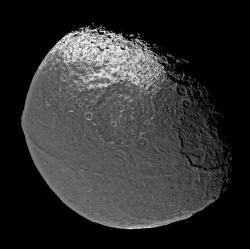Saturn’s moon Iapetus is one of the stranger objects in our Solar System. Unlike other objects its size, Iapetus is walnut-shaped, with a clearly defined chain of mountains along its equator. How could it have formed billions of years ago with the rest of the Solar System, and yet still have its unique shape?
New NASA supported researchers have developed a computer model that seems to accurately explain the series of events that Iapetus went through to arrive at its current shape.
Billions of years ago, shortly after its formation, Iapetus spun quickly, taking just 5 hours to complete a rotation. This fast spin gave it the oblate walnut shape it has today. Over time, its rotation slowed down to about 16 hours. It also cooled down enough that its surface froze solid. It couldn’t absorb the excess surface material. Instead, this rubble built up the chain of mountains around its equator. At this point, its formation completely halted in its tracks. The moon now orbits at a relatively slow rate, turning only once every 80 days.
Scientists were able to confirm these predictions for Iapetus, using observations of its rocks containing short-lived isotopes aluminum-26 and iron-60. These decay at a rate that allowed scientists to carbon date the moon at roughly 4.564 billion years old. About the same age as the Earth.
NASA’s Cassini spacecraft is due to make another flyby of Iapetus on September 10, 2007, passing within only 1,000 km (621 miles) of its surface.
Original Source: NASA Jet Propulsion

